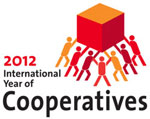Cooperatives Define Themselves
Posted: November 2, 2011
On the same day the world was officially proclaimed home of seven billion souls, the United Nations General Assembly officially declared 2012 as the International Year of Cooperatives with the theme of “Cooperative Enterprises Build a Better World”.
“This Day of 7 Billion – is not about one newborn, or even one generation,” Secretary-General Ban Ki-moon said. “This is a day about our entire human family.”
 According to the U.N., one billion of the seven billion souls on the planet belongs to a cooperative and that cooperatives, especially in agriculture, contribute to “poverty reduction, employment generation and social integration” around the world. Agricultural producers are more likely than most to belong to a cooperative, and rural residents in general more than city dwellers.
According to the U.N., one billion of the seven billion souls on the planet belongs to a cooperative and that cooperatives, especially in agriculture, contribute to “poverty reduction, employment generation and social integration” around the world. Agricultural producers are more likely than most to belong to a cooperative, and rural residents in general more than city dwellers.
The latest Global300 report, released by the International Co-operative Alliance this week, says that the world’s largest 300 co-operatives generate revenues of $1.6 trillion—equal to the GDP of the world’s ninth largest economy. Most of the largest cooperatives are found in the developed economies of France, Germany, Japan, Netherlands and the United States, with 30 per cent engaged in the agriculture and food sectors, 23 per cent in retailing, 22 per cent in insurance and 19 per cent in banking.
The root of the cooperative business model is the root of the very word itself - co-operate; to operate together as a unit. When farmers, producers, workers, and consumers find that they can accomplish more if they cooperate collectively than they could as individuals, a cooperative is born.
“Cooperatives have a long history going back to England in the mid-1800s when producers would get together to help market their products and that has resulted in the cooperative system here in the United States,” says Dan Kelley, an Illinois farmer and chairman of GROWMARK, one of the oldest and most successful agricultural co-ops in the country. “If you think of products like Welch’s grape juice, Florida’s Natural, SunMaid Raisins – those are cooperatives that have a national brand and market in some cases world wide.”
Cooperatives can also be credited with the rapid expansion of the ethanol industry in the Midwest over the past decade. A significant percentage of plants currently in production are still farmer-owned cooperatives, run by farmers in the area who found out what they could accomplish by working together.
Cooperatives define themselves in the spirit of working together to achieve a common goal. That is something to celebrate.